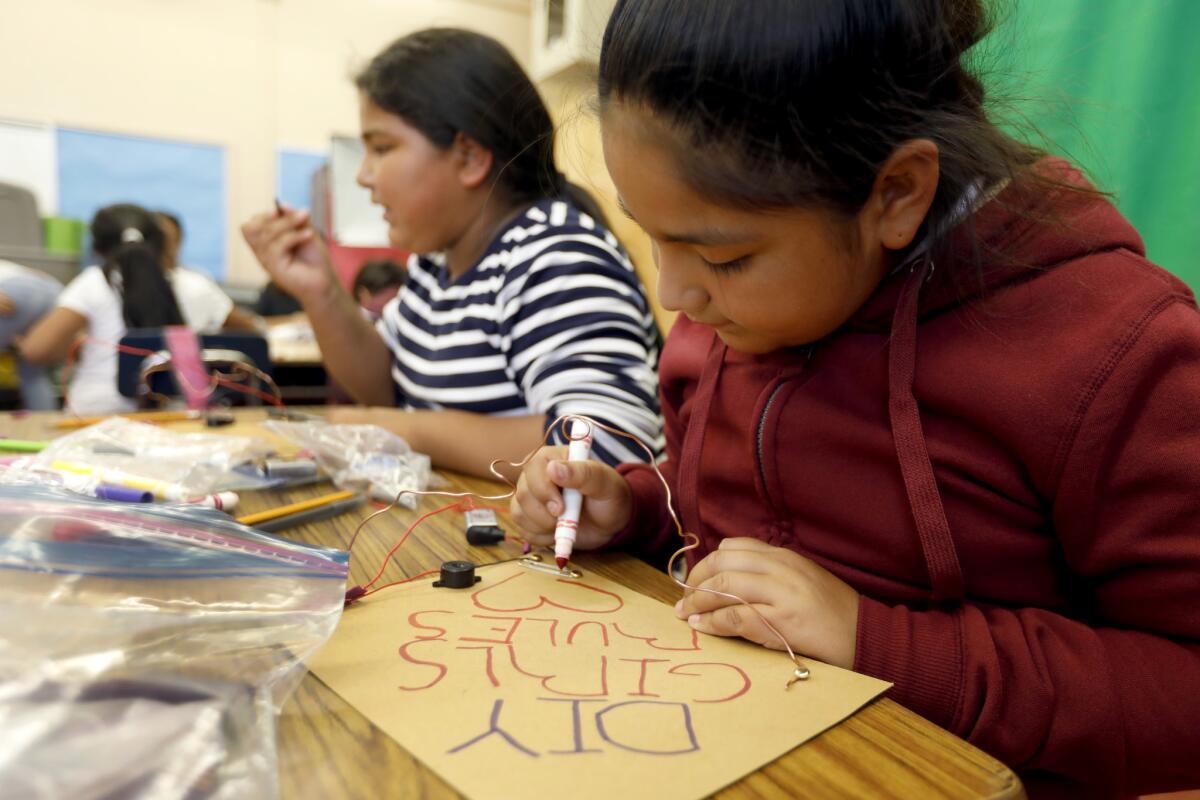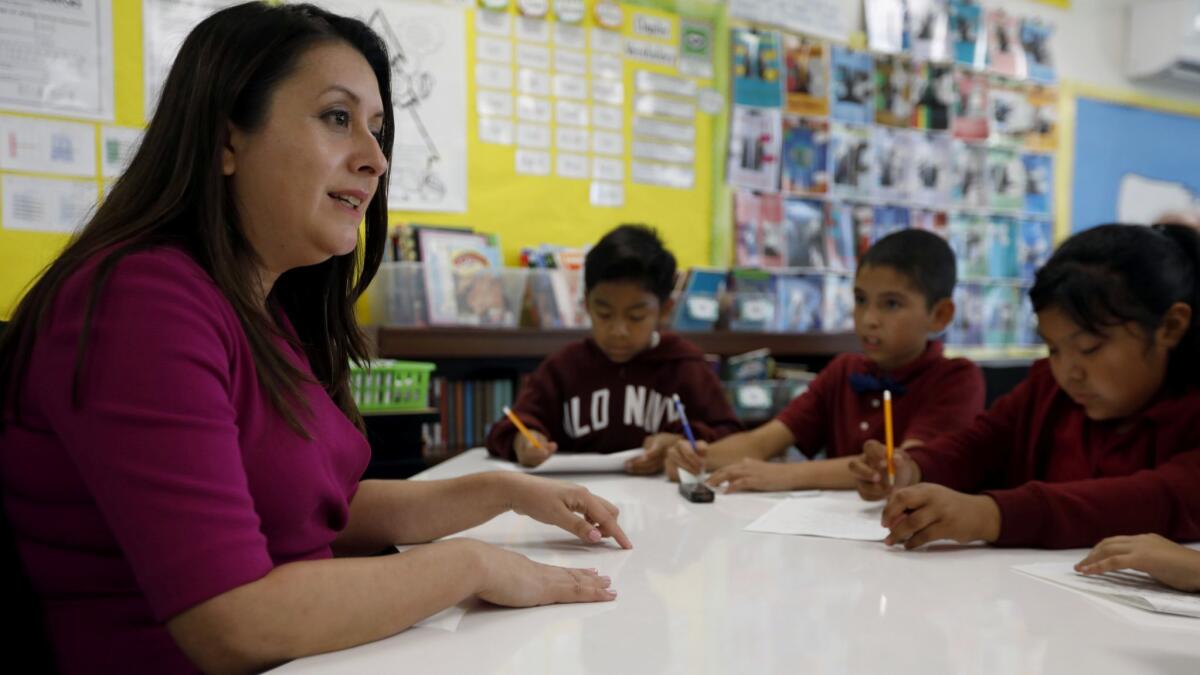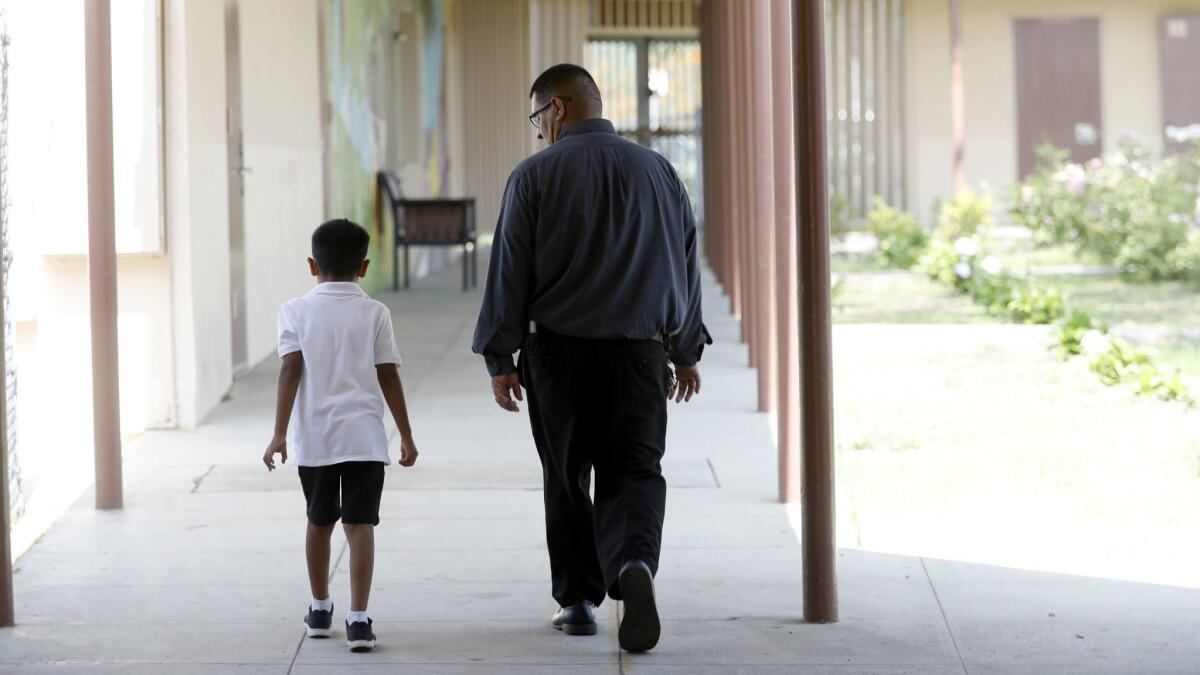Must Reads: For children trapped in poverty, breaking free is getting harder

- Share via
Luz Rivas knew the two dozen fifth-grade girls sitting before her. Not by name, but by experience.
She once lived in tight spaces, shared homes, back houses, a garage. It was back in the 1980s, when she and her mother and sister would get squeezed out of one place, hear about another and start over again. It’s still that way for children in the Pacoima neighborhood around Telfair Elementary, only more so.
“I hated that assignment in school when they asked you to draw your house,” Rivas, 44, told me. “I didn’t want to draw a garage.”
Rivas managed to overcome the disadvantages, and the path she followed began at Telfair. Now, three decades on, she was back at her old school, having gone to MIT and Harvard, having become an electrical engineer and then a member of the California Assembly.
It was here in fifth grade, Rivas told the students, that she discovered an interest in engineering while trying to figure out how to program an Apple IIe computer. So when she started a nonprofit called Do It Yourself Girls, an after-school tech program that has served more than 2,000 fifth- to 12th-grade students at 14 schools, Telfair got the first chapter.
“Why did you decide to join DIY?” Rivas asked the students.
“I’m going to start my own DIY,” one girl said with full authority. “I thought it was not going to be that fun, but then we did the first project and I thought about it, and it was fun.”
“I want to be an engineer like my sister,” said another.
Can it happen? Of course. Rivas rose up, and others will follow.
“But it’s more of a challenge now,” said Trini Rodriguez, former Telfair student and cofounder of Tia Chucha’s Centro Cultural and Bookstore in Sylmar. “No matter how hard you try to meet your needs, there’s an obstacle instead of a bridge.”
Many of Telfair’s students don’t have computers or Wi-Fi connections at home.
Many of the area’s manufacturing and aerospace companies died years ago, giving way to minimum-wages and two-job hustles that stack crushing burdens on families.
And for public schools in California, including Telfair, the golden age of full investment is a distant memory.

In populated urban areas, we don’t like the state of our schools, and we’ve spent years squabbling about what’s wrong and how to fix them.
We make arguments for more charters, fewer charters, more resources, more accountability, more decentralization, more testing, more parental involvement, more curriculum overhauls, more repercussions for teachers who don’t cut it. The Times recently reported that L.A. Unified Supt. Austin Beutner is considering a major realignment, with 32 separate school clusters, more local control and a smaller central bureaucracy.
But after decades of combat, we’ve flunked consensus and compromise. Sure, schools can and should do better, but we’ve unrealistically expected them to magically compensate for the burden of widening economic disparity.
In well-off communities, students tend to do pretty well.
In poor communities, they tend to struggle.
It’s easy, from a distance, to look at disappointing test results and determine that a school is a failure.
Telfair, admittedly, doesn’t have a very good report card. It lags behind the district and state averages in student performance. When the most recent statewide test results came out, Telfair was up 2% in language arts and down 2% in math. In each subject, less than one-third of Telfair’s students met or exceeded minimal standards as established by the state.
But those scores are less a measure of promise than of poverty.
When you visit classrooms, when you go to the motels and garages where children live, when you get to know that the heaviest load isn’t what’s in their backpacks, when you learn that some teachers are working 10-hour days, tutoring students during recess and lunch and volunteering to run after-school clubs for no pay, you begin to realize it’s not the schools that are failing — it’s everything else.
Society, culture, politics, public policy. The economy is tilted, the hill is steep.
It was early September when I began visiting Telfair, which had more students classified as homeless than any other in Los Angeles Unified last year. A school at which virtually every student is poor enough to qualify for free and reduced-price meals.
“Every year, we have to do more with less.”
— Jose Razo, principal of Telfair Elementary School
The remarkable thing is how common that profile is in California, home to the world’s fifth-largest economy, happy hordes of 1-percenters and the highest rate of poverty in the nation when housing costs are considered. About one-fifth of the state’s residents can’t afford basic needs, according to the Public Policy Institute of California, and 45% of the state’s children are poor or nearly so.
A gaggle of researchers concluded in September that California students learn on par with students in other states, but many of them start far behind and never catch up. A lack of quality childcare and preschool education was cited, along with “a poor record of identifying young children with disabilities.” Latinos, African Americans, recent immigrants and foster children struggle the most, according to the research. Telfair, almost entirely Latino, hits three of those four categories.
“The tests don’t tell the whole story,” Principal Jose Razo argued one day in his office. “A test looks at one day in the life of one kid at one particular time, and if that kid is hungry that day, or tired that day, or slept in his car, or his mom had an argument with his dad who left the day before, that’s not a true assessment.”
He wasn’t making excuses. Razo, as much as anyone, wants his district and his school to do better, and he wants his students to believe they’re on track to go to college. Telfair is draped in the banners of universities from all over the country.
But as Luz Rivas put it, Telfair lacks some of the basics that existed when she was a student there.
“We’re not investing in the students early enough,” she said, “and I think of these things as a legislator now. When I was here, there was a full-time nurse and when you were sick, you went to the nurse. It was a given. The library was open every day and it had a librarian.”
Trained librarians gave way to library aides years ago, then to locked doors, with books kept in a vault – beyond the reach of students who need extra stimulation, not less.
Fifth-grade teacher Maria Alvarez told me her students get just one hour of library time each week. She said she got a note from the part-time nurse advising her not to send students her way unless there’s a significant problem, and Razo said he and other staff often take on first-aid duties.
Telfair tries to compensate with programs such as DIY Girls. Razo’s childhood mentor was a band director who fused music and discipline, so the principal started a mariachi program at Telfair three years ago in conjunction with LA’s Best, the after-school enrichment service. But his school doesn’t have the janitorial or maintenance staffs it once had. The asphalt playground is cracked and chunking apart. Two urinals in a boys bathroom were out of order, draped in black plastic, and a janitor said it could take weeks for someone from the district to take a look. One student’s grandfather volunteers to maintain the garden out front.

When I went to California public schools in the 1960s, the state served as a clinic for the entire nation, demonstrating that a full investment in grade school, colleges and universities was key to upward mobility. Funding per student was near the top. But since then, the state’s standing has plunged.
“California is 46th in the nation,” said Kelly Gonez, the school board member who represents the northeast San Fernando Valley, “even though we have the largest population of English learners of any school district.”
Other rankings put California closer to the middle of the pack, based on different methods of calculation. But Gonez said you can’t talk about school performance without taking the funding decline into account, and Razo summed it up this way:
“Every year, we have to do more with less.”
The principal said that given the trauma his students experience — frequent moves, cramped quarters, family separation, violence, depression, the constant stress of barely surviving — he could sure use a psychiatric social worker. Same for literacy and math coaches, but hiring for those positions would mean sacrificing other critical needs. Because so many of his students are English learners from poor families, he decided to hire an extra first-grade teacher to bring class sizes down to 16, so the students get plenty of attention at the beginning of their education journey.
“We’re not investing in the students early enough.”
— Assemblywoman Luz Rivas
This is not to say there have been no efforts in Sacramento or individual districts to lend a hand. L.A. Unified has mental-health screening, wellness centers and a program to link homeless students and their families with housing and other service providers. Recently, the school board approved a resolution backed by Gonez to explore permanent and interim housing solutions for families, on district properties, in partnership with government, nonprofit and private parties.
But at the moment, need exceeds help, and by some measures, chronic exposure to childhood stress — including abuse, neglect and household dysfunction — can hinder brain development and cause physical and mental-health problems. Not temporarily, but for life.
San Francisco physician Nadine Burke Harris told me exposure to four or more stress triggers as a child has been linked to rates of adult heart disease twice the normal rate. When I told her about Telfair and the number of students living in motels and garages, she was reminded of a patient whose family of six lived in one room and struggled when the father lost his job.
“I began to see changes in her weight, her rate of infection, changes in behavior and school performance. I was seeing it right in front of me — the manifestation of toxic stress,” said Burke Harris, founder of the Center for Youth Wellness and author of “The Deepest Well: Healing the Long-term Effects of Childhood Adversity.”
Burke Harris prescribes more early intervention, along with coordinated support from the judicial and welfare systems. When I asked about the cost, she threw back at me the high cost of incarceration and long-term healthcare for preventable chronic diseases.
Last week, a task force called on Gov.-elect Gavin Newsom to deliver multibillion-dollar investments in child care, tax credits, rental subsidies and more to help close an income gap that has made child poverty “a human and a fiscal crisis” in California, in the words of co-chairman Conway Collis. The group — with public, private and community representatives — said such investments could produce long-term savings and could improve living conditions for 450,000 of the state’s poorest children in the next four years.
As I’ve said before, I think schools are underutilized. They should be redesigned as community centers that stay open in the evening for student tutoring, parenting skills training, and family planning healthcare for adults who don’t yet have the means to support large families. They need more support from local nonprofits, neighborhood businesses and billion-dollar corporations. And decades after the collapse of blue-collar manufacturing and aerospace jobs in the Valley and elsewhere, they need to be better outfitted to prepare students for jobs in technology, healthcare and other developing industries. A DIY Girls and a DIY Boys at every school would be a good start.
Shame on us for sitting back, in cynical judgment, while schools go without the tools once considered essential to a healthy, nurturing educational environment, and students already at a disadvantage fall further behind because of it. What better way to benefit everyone in California than to return to the days when we cared enough about our children, and the future, to give them their best shot at success?
The day Luz Rivas visited her old school, Telfair Principal Razo stood in a corner of the classroom, a man of proud bearing. When Rivas was finished speaking, he had something to say, and it echoed an article of faith he had shared with me weeks earlier at our first meeting — he wants every student to know, no matter how difficult their lives or how long the odds against them, that he and his teachers believe in them.
“I’ve told you before, I have two daughters and I want the best and most out of my daughters,” Razo said to the class. “You guys can do anything. Maybe I could have the first female president come out of my school.”
When the speeches were done, the girls went to work. Within minutes, they were all budding engineers.
The DIY staff had set work kits in front of each student, and the girls used batteries, buzzers and switches to create a circuit and send energy coursing along a twisted wire. It was a variation of the game Operation. The girls had to carefully run a looped wand along a self-designed roller coaster of wire, and if the loop made contact, it set off the buzzer.
Shrieks, giggles, laughter.
The sound of trapped potential set free.
A note on this series: Facing child poverty in L.A. and our own conflicting emotions »
Produced by Jessica Perez
Sign up for Essential California
The most important California stories and recommendations in your inbox every morning.
You may occasionally receive promotional content from the Los Angeles Times.








